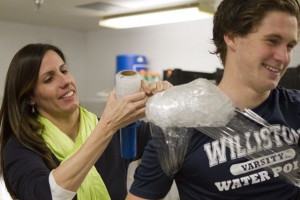Editor’s note: This annual speech by Williston Archivist Rick Teller ’70 takes its name from the manufacturing business school founders Samuel and Emily Williston (although buttons themselves are not usually the focus). This year, Mr. Teller spoke during Upper School assembly on October 1, 2014.
Good morning. We call this the button speech. For those of you who are new to us, it is an annual presentation concerning some aspect of Williston Northampton history. For those of you who are not new, there is absolutely no truth to the story that it’s the same every year. Let me add that the only reference to buttons that you will hear this morning has already happened.
OK, a caveat. A few of you seniors heard a portion of today’s talk back in freshman year. I suspect that fewer of you remember, so I’m not especially worried. And it seems important this year to talk about Northampton School for Girls, since this fall is the 90th anniversary of their founding.
Northampton School for Girls is the “Northampton” in our name. They merged with Williston Academy in 1971. Their history, their legacy is an integral part of who we, meaning you, are, here in 2014.
So let’s go back to 1920. Northampton School history really begins with the Capen School for Girls. Capen was a small but highly regarded school located next to Smith College in Northampton. (In fact, those of you who attended the Smith College Campus School are intimately familiar with the former Capen property.)
The Capen School did not survive the death of Miss Bessie Capen, its headmistress and owner — talk about a private school! Capen was one of a great many girls’ academies that have since vanished from the educational map. Early in the 20th century girls could not make the assumptions about education and careers that you do now. If a woman attended college at all, she might go to a state normal school, and prepare for a career as a schoolteacher. Most private colleges were male enclaves, but there were a number of fine women’s colleges, either associated with men’s schools, like Radcliffe or Barnard, or independent colleges: Wellesley, Smith, Vassar, Mount Holyoke — whose mission was to provide women an education equal in rigor to that offered to men at Yale and Amherst. An ambitious young woman might attend one of these colleges, although there was certainly no guarantee, or even encouragement, that she continue a professional life after college.
Continue reading →


